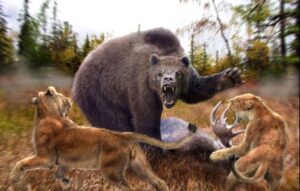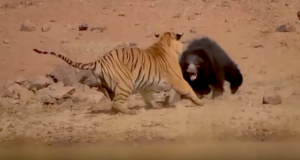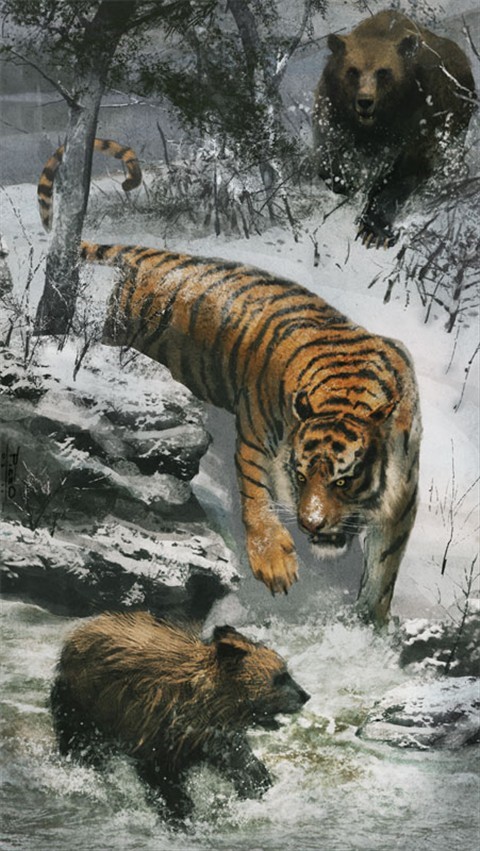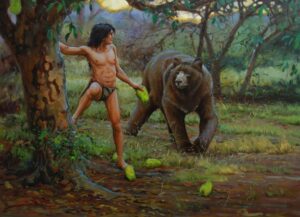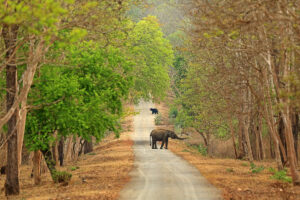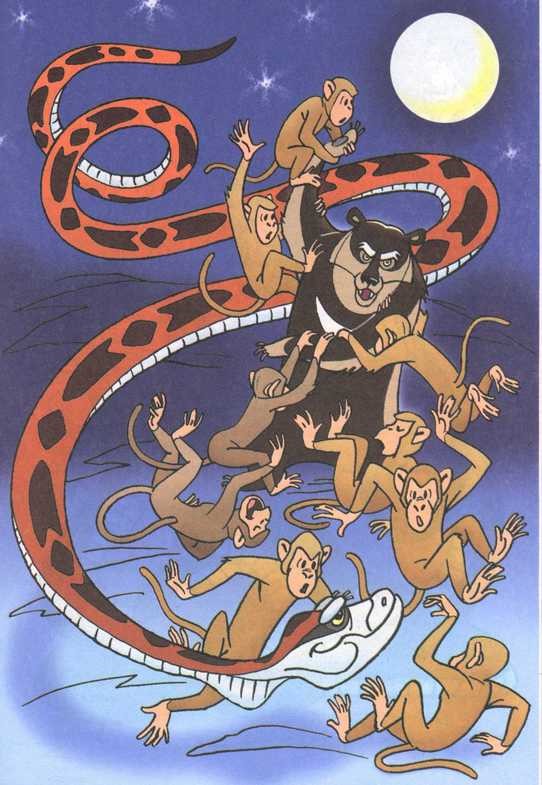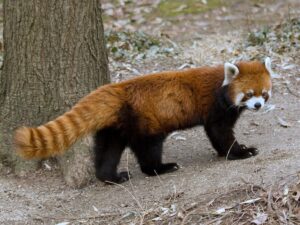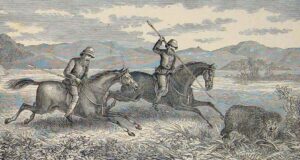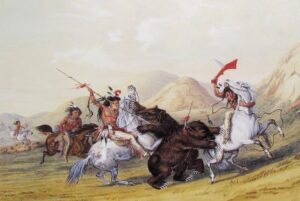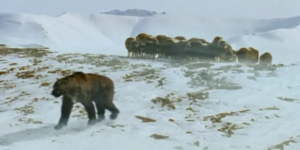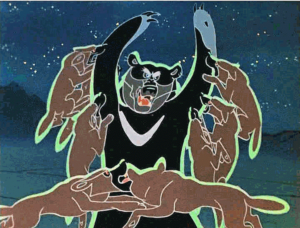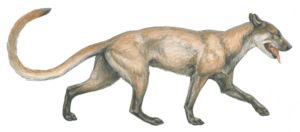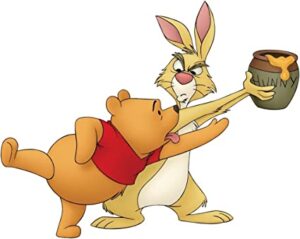The television show Care Bears, inspired by the American Greeting Card characters (and later their toy adaptations) was probably one of those elements that got me interested in animals when I was a child. It seems to be the only element in the world where Bears are given more importance than animals who would either rival them or obtain some kind of superiority over them. Those animals in the Care Bears team who are not Bears are (ironically) referred to as the ‘Care Bear Cousins’; examples include Brave Heart Lion, Lotsa heart Elephant, Proud Heart Cat, Playful Heart Monkey, Bright Heart Raccoon and Swift Heart Rabbit just to name a few
However in reality many of the Care Bear cousins would actually share a rivalry with/against Bears which is something I came to understand as I watched the series further. Despite Care Bears being cute and cuddly just as any Teddy Bear would be and inspiring love and kindness, it is a known fact that Bears are actually deadly animals in real life This inspired me to want to write about how that presents itself
Lions
Lions, kings of the animal realm, reside predominantly in Southern and East Africa, with a small population in Western India. Bears inhabit North America, Europe, India, Nepal, China, Japan, and much of Southeast Asia. Although India stands as the exclusive home to both Lions and Bears, these species do not interact due to historical wildlife dynamics. The Gir Forest, once shared by Bears and Lions, now hosts only Lions as top predators. Historical records reveal that in the Ice Age of the United States, Bears and Lions competed fiercely for territory and food. While a single Lion could not defeat a Bear, Lions in groups of two or three could subdue or repel them. Prehistoric Lions targeted horses and reindeer, later expanding to hunt mammoths, bison, and musk oxen, occasionally even preying on Bears.
Prehistoric Lions and Short-Faced Bear fighting over a deer
In ancient Rome, there might have been clashes between Bears and Lions within the Colosseum. However, today, the competition between Bears and Big Cats is mainly limited to India and Asia. Within the Asian Bear category, the Asiatic Black Bear and the Sloth Bear stand out for their aggression, occasionally entering conflicts with Tigers. Back during the British rule in India, Bears were considered more perilous than Tigers, leading to them being a sought-after target.
In the 3-part BBC documentary series Tiger Spy in the Jungle, set in Madhya Pradesh’s Pench National Park, believed to be the inspiration behind Rudyard Kipling’s The Jungle Book, a confrontation occurred between a female Sloth Bear and a female Tiger. This encounter was characterized by vocalizations rather than direct physical combat, ultimately resulting in the Bear retreating. In both cases, the animals were mothers safeguarding their young, although the Bear left her cubs momentarily, while the Tigress dined with her offspring. Another antagonist of Sloth Bears and Asiatic Black Bears is the Leopard, with this rivalry also playing out in Sri Lanka. Like with Tigers, Bears sometimes seize the prey of a Leopard when the opportunity arises or when the Bear has the upper hand.
In parts of Asia and Europe, Asiatic Black Bears sometimes clash against Tigers and are a notable part of their diet, as seen from traces in Tiger excrement found by Russian hunters. A curious incident involved a Tiger mimicking an Asiatic Black Bear’s mating call to lure and catch one. Jim Corbett (1875-1955), a British officer who hunted dangerous Tigers and Leopards, personally witnessed an Asiatic Black Bear fighting and fend off a Tiger before succumbing to death due to injuries from the loss of half a nose and torn scalp. Corbett also noted Black Bears scavenging Tiger kills. Unlike Sloth Bears, Asiatic Black Bears show more predatory behaviour, targeting larger animals and breaking their necks for prey. While there’s no evidence of Himalayan Brown Bears confronting Tigers, South Chinese and Siberian Tigers have been known to hunt Bears in Siberia and parts of China.
Brown Bear coming to the rescue of her cub from a Tiger
The rivalry between Bears and Tigers might have been one of the aspects followed in Rudyard Kipling’s The Jungle Book stories (although it was not a major subject of the stories). Baloo the Bear (debated to be either an Asiatic Black Bear or a Sloth Bear) is an ally to the Wolf Pack that takes in Mowgli the Man-Cub and protects him from the villainous Tiger Shere Khan and his counterpart the Jackal Tabaqui. Like with other Wolves, Baloo teaches Mowgli about the laws of the jungle and another ally to him, the man-cub and the wolf pack is the black leopard Bagheera.
The smallest of the Asian Bears, the Sun Bear, despite being a vicious animal has never harmed humans although there has been only one instance of a Sun Bear fighting a Tiger and surprisingly both animals died from their wounds.
Elephants
It is widely known that Elephants often react strongly to Bears, charging at them. This behaviour was observed by British officers in India, particularly one who saw a friend’s Elephant becoming agitated and aggressive not only around Sloth Bears but also Cows. In the BBC documentary The Real Jungle Book Bear, which followed the Sloth Bear who is thought to have inspired the character of Baloo in Rudyard Kipling’s The Jungle Book, an incident was captured where a Sloth Bear drinking at a waterhole retreated when Elephants and Chital Deer approached. Interestingly, the national park where this documentary was filmed has the Sloth Bear as the main attraction. However, near Tadoba national park, the only setting of The Jungle Book outside Madhya Pradesh, a female Sloth Bear grew agitated upon seeing domesticated Elephants entering the park with visitors. Her aggressive behaviour led to disruptions, forcing safari cancellations. Once, she even chased an Elephant and its rider out of the park. She was eventually captured and relocated to another national park.
Sometimes hunting Bears from Elephant back was an added advantage for hunters since Bears and Elephants loath each other. Elephants could enjoy their rage of chasing a Bear and walking the animal into the ground for their riders to shoot at or spear. This was the case with both the Asiatic Black Bear and the Sloth Bear
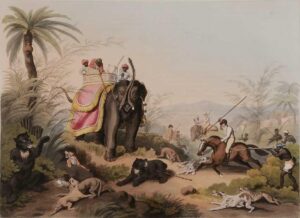
British officers and their Indian guides on Elephantback and Horseback hunting Asian Black Bears with the help of their Dogs
Monkeys
Smaller than bears, monkeys instinctively climb trees upon seeing an approaching bear. In The Real Jungle Book Bear, monkeys quickly climbed a tree when a bear approached while they were eating jackfruit. The bear posed no threat and focused on the jackfruit, while the monkeys stayed in the tree until the bear left. Reports from the 1970s indicated Asiatic Black Bears hunting langur monkeys, a phenomenon occasionally reported since then, though less frequently than initially. In The Jungle Book tales, the Bandar Log, a troop of monkeys, abduct the wolf-raised boy Mowgli, prompting his mentors, Baloo the Bear and Bagheera the Black Leopard, to successfully rescue him with assistance from the python Kaa. Similar to Bagheera and Kaa, Baloo also defends Mowgli and engages in battles the monkeys, often roaring before swiping at them.
Baloo and Kaa fight the Bandar-Log in The Adventures of Mowgli (1967-1973)
Raccoons
Raccoons usually seek safety in holes or trees when confronted by a bear. In certain situations, raccoons may fight back if the bear persists, although bears tend to have the upper hand. Bears employ similar tactics to Tigers when hunting raccoons, sneaking up on them while they are distracted by garbage or fruit. Occasionally, due to their agility, raccoons can swiftly escape if a bear’s attack is unsuccessful. It is erroneously believed that the Red Panda is a relative of the Giant Panda since both have the same name and both are found in China. However the Red Panda is more related to the Raccoon than to the Bear
The Red Panda which is a Raccoon not a Bear
Horses
Horses are often intimidated by Bears and are known to flee from them at first sight. This was observed by many British officers in India and this was used to an advantage by many who went hunting and chose Bears as their targets while on horseback.
Sheep
Bears, particularly Grizzly Bears, have a history of attacking and killing sheep, prompting angry farmers to shoot them to safeguard livestock. Current efforts aim to prevent bear attacks on sheep and other animals. In various regions like Asia, Europe, and the United States, bears hunt animals such as Deer and Wild Sheep. For example, Asiatic Black Bears, known for their carnivorous nature, prey on creatures like the Takin, a type of wild sheep. In the United States and Europe, bears are observed chasing and hunting Deer. Bears also pose a threat to Musk Oxen, which are more related to sheep and goats than cattle. Musk Oxen have historically formed protective circles and used their horns to defend against Wolves and Bears. However, Bears can sometimes disrupt these circles, even though Musk Oxen are better at deterring Wolves than Bears. Despite this, Bears still hold a notable advantage over Musk Oxen.
Dogs
It is ironic that while Bears and Dogs are distant relatives, they are antagonistic towards each other. A single dog will inevitably flee from a Bear but larger numbers domesticated or wild will always work together to either kill or see off a Bear. Greyhounds were sometimes used in historical times to hunt Bears while accompanying their masters who would be seated on Horses with guns (see section on Elephants for more). Some members of the Dog family such as Foxes will sometimes scavenge Bear kills but they take a great risk in avoiding injury from the Bears.
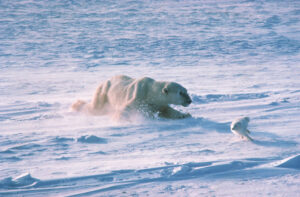
Polar Bear chasing away Arctic Fox
There are a few members of the Dog family who will always rival Bears or target them for food. In the BBC documentary Land of the Tiger which focused on the wildlife of India, a Sloth Bear was chased away by a Jackal defending his family in the Kanha national park, one of the settings for The Jungle Book. Wolves will sometimes also target Bears for food although this is more in the case of Bhutan and Tibet. These instances connect instantly to Kipling’s stories, where the Jackal (alongside) rivals the Bear and the Wolf aids the Bear. Kipling’s tales also depict the Dhole or Indian wild dog as a greater threat than the Tiger, an adversary of the Wolf pack. Mowgli and the wolves unite against the Dhole, with Baloo’s physical prowess aiding in their triumph over the Dholes and ending their reign of terror.
Baloo fights Dholes in The Adventures of Mowgli
Cynodictis the ‘Bear Dog’
RabbitBears and Rabbits live on the same continent but the Bear will always view the Rabbit as a source of food. While Bears are fast runners, Rabbits are often able to add swift movements to their runs and thus would be capable of overtaking an attacking Bear. Winnie-the-Pooh is the only element where the Bear and the Rabbit get along
Penguin
Given that Bears and Penguins live on different continents it is way out of the question that either species would come into contact with each other. Ironically a few games involving both the Polar Bear as the Penguin have the latter as the hero and the former as the villain
Still from the Android App ‘Flying Penguin’



